Keeping chickens as pets has become increasingly popular in recent years. With their charming personalities and delightful chirps, clucks, and chicken chatter, chickens make excellent outdoor companions.
But where do you start? What are the best chickens to keep as pets? How much space do they need? Will they freeze in the winter or melt in the summer? Do I need to live in the countryside with lots of land? And what are the benefits of keeping chickens as pets besides eggs?
Let’s explore all those questions and more in this in-depth article.
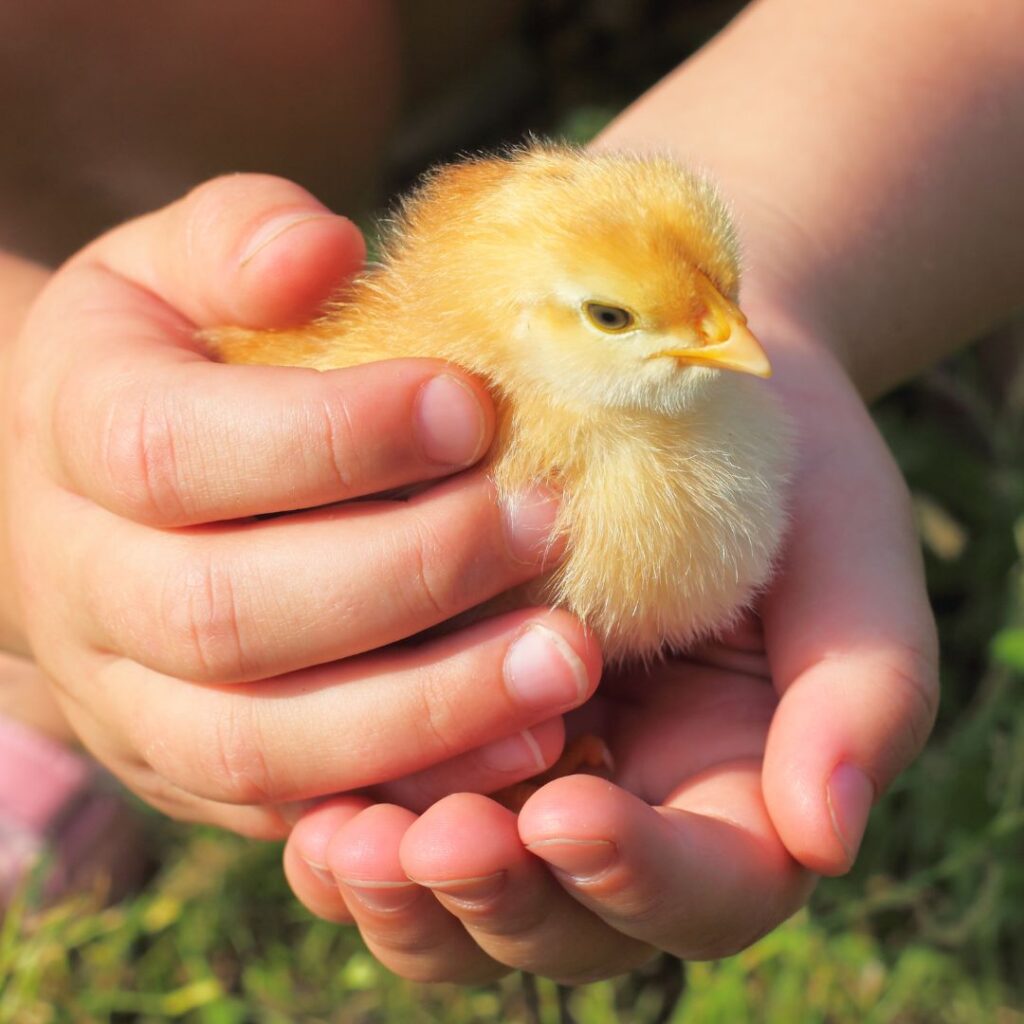
Are You Considering Having Chickens For Pets; What You Need To Know
First, you must know if your town or city allows livestock, specifically pet chickens. You can start with your board of health, and they’ll direct you from there. In our town, the Animal control division of the police department regulates all domestic, and livestock kept or owned by residents.
How do your neighbors feel about clucking, crowing, and all that natural music? Better to ask them upfront.
Then you need to know what you ‘want’ from a chicken. Eggs? Meat? Dual purpose breed? Pet-only breed? Ornamental chickens ( Bantam breeds) or 4H birds? Will small children be helping with chicken chores?
As if you thought those decisions were tough, now you need to size it all up; what kind of space are you willing to allot to your ‘hopeful’ new flock? You’ll need to account for ‘coop’ space and outdoor pen/run size. More on coop size further down this article.
You knew this part was coming: What is your budget? Do you have an old outside building you can convert safely into a coop? Will you be purchasing a pre-fabricated coop? Make a list of supplies you’ll need, such as bedding, feed, waterers, feeders, fencing, etc.
If you are starting with baby chicks, you’ll also need a heat source to keep them warm, a thermometer, different size feeders, and of course baby chick and the different size of feeder and of course, the different type of feed while they grow.
Now, if you are planning on hatching eggs, you may want to know more about how that all works, etc. check out our article on hatching chicks here.
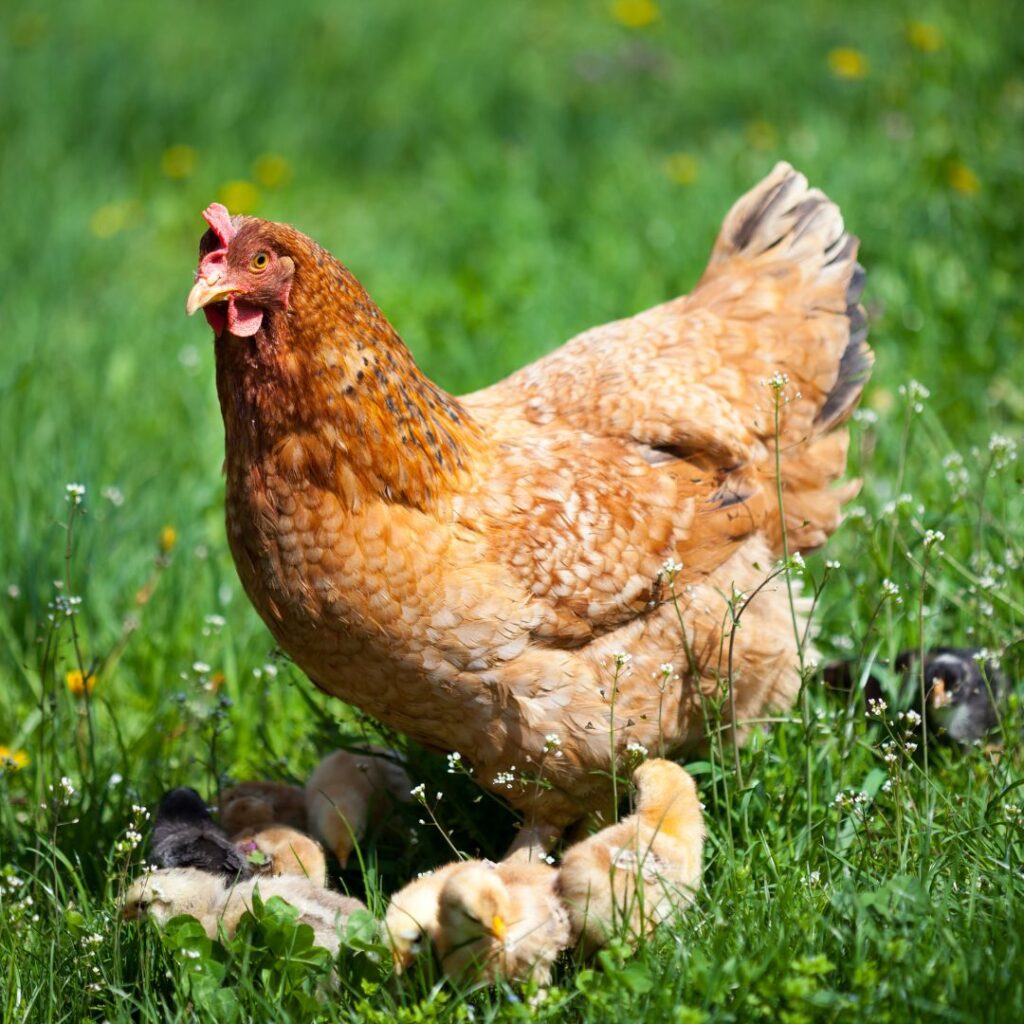
How Much Space Do Pet Chickens Need?
Chickens need enough space to roam freely without overcrowding or stress. The amount of space required for a flock of pet chickens depends on several factors, including breed (bantams require less space than standard-sized hens) and your climate (hot weather requires more space).
As a general rule, plan on having at least 6-10 square feet per bird inside the chicken coop, aka hen house, and 10 + square feet in an enclosed area such as a run (sometimes called a pen or yard).

The coop inside will need space for the roost, a nest box for every four hens, and feeders and waterers. Always allow extra room for “just a few others” future moments.
Outdoor run space will be for roaming, dust bath area(s), and perches to add lateral variety to their daily outdoor time.
For your convenience, we will link to all our chicken breeds so you can read more specifics on their individual coop needs.
Are chickens good family pets?
Many families may not realize that chickens can make good pets. Chickens also provide entertainment, given their fascinating and funny personalities.
They come in all shapes, sizes, and colors, making them so much fun to observe. Chickens can learn to recognize their owners and respond when called.
They’re experts at finding bugs; you may find your backyard insect population has decreased just from having one around.
Remember that they can also provide a fresh source of eggs for the family. A pet that earns its keep is worth a 2nd look.
While there are friendly birds, remember that some will lay more eggs than others. Some breeds can lay up to 5-6 eggs per week, equaling 300 eggs per year. Did you know not all chickens lay brown eggs? Some chickens lay blue, green, and even pink eggs.
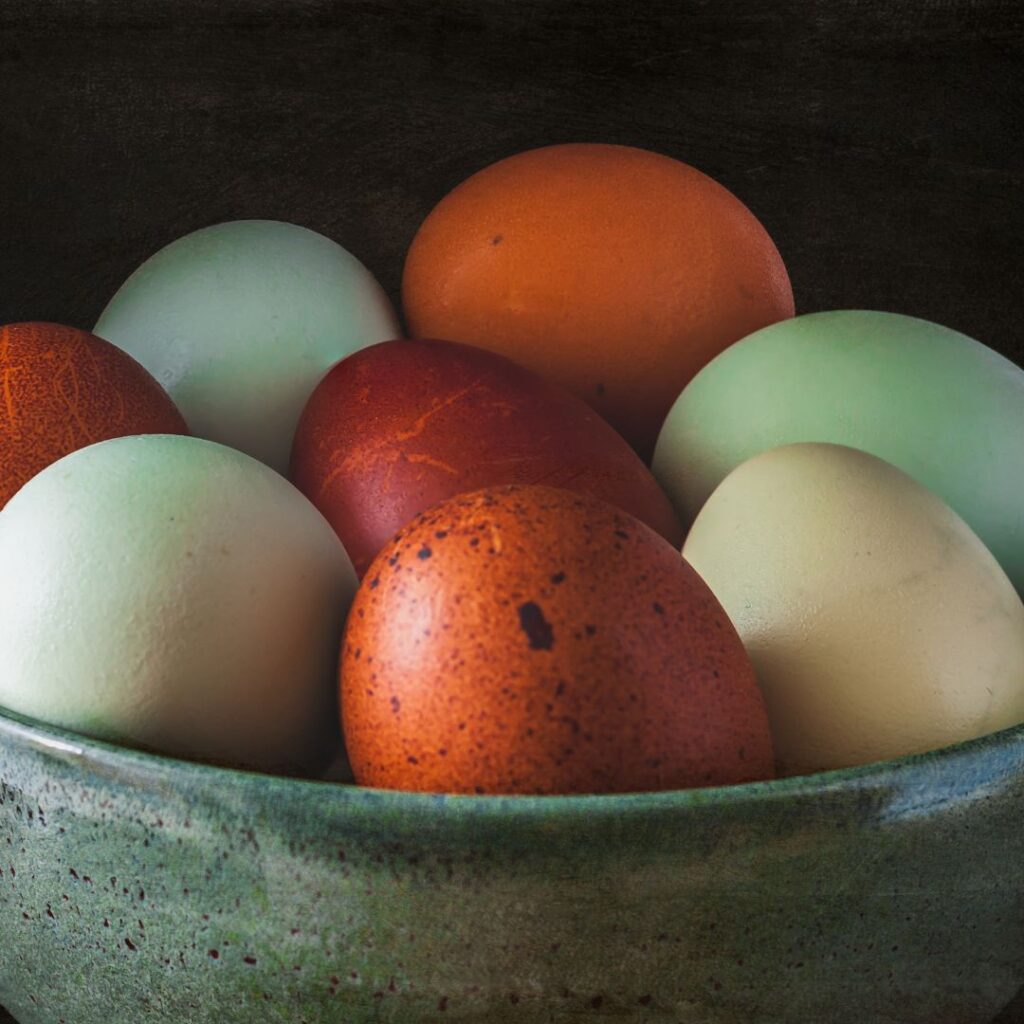
Are chickens hard to keep as pets?
Chickens are easy to keep as pets. Keeping chickens as pets can be a fulfilling and fun experience. However, like any other pet, feathered pets like chickens have certain maintenance expectations. It is essential to research the breed of chicken you are considering, as not all breeds have the exact requirements or personalities.
Here is what a daily/weekly routine looks like:
Morning:
Collect Eggs
- Clean and change the water.
- Inspect and add fresh feed
- Open door(s) if you allow your flock free range.
Afternoon:
- Check your flock if they’re free-ranging (do this more often if possible).
- In winter, check for frozen water; in the summer, add ice cubes to the water.
- Treat time! Toss some scratch or share some veggie scraps.
Evening:
- Do a headcount, and ensure everyone’s home and in their coop.
- Check feeders and waterers.
- If needed, top off bedding in nesting boxes.
- Lock up for the night.
Weekly:
- You’ll want to clean the coop bedding/litter in warmer weather weekly. Excess’ waste’ produces ammonia and is toxic to your flock. In the winter, ‘turn’ the litter and add fresh, clean litter to the top.
Note: it’s a good idea to have a compost area to toss the litter/waste as you clean the coop.
- Inspect the outside of the coop and run area for repairs.
Read About Chicken Care In Winter Months Here.
About The Top 19+ Friendliest Chicken Breeds (with pictures)
Here is a list of all our favorite chicken breeds for pets. Some are huge; some are bantam. All will lay eggs and provide years of entertainment and nutritional benefits. We’ll cover how many eggs per week you can expect, which are the best cold-hardy chicken breeds, and their size and appearance.
Read more about how long chickens lay eggs here.
Australorp
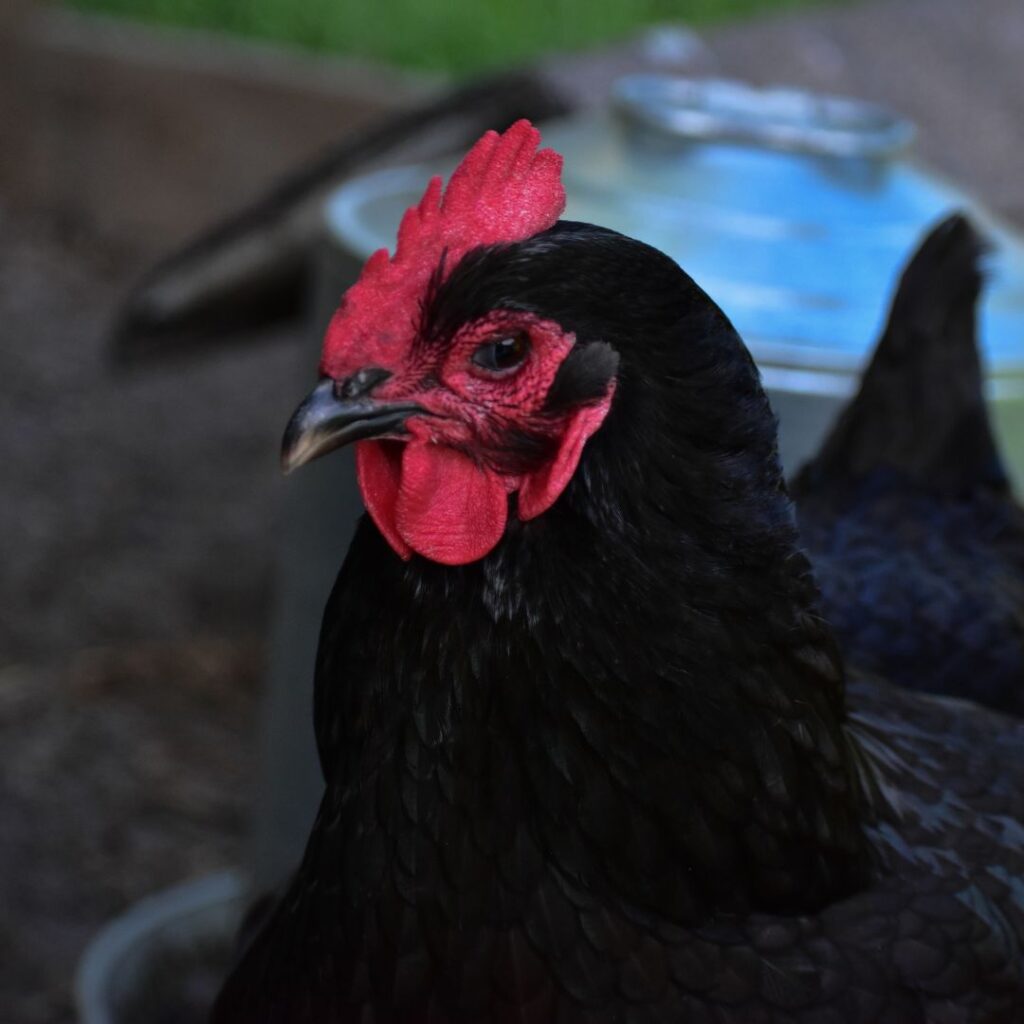
With their striking color and impressive size, the Australorp adds unique visual features to a farm or backyard coop.
With its impressive egg production – up to 280 large light brown eggs per year (5-6 eggs per week) – the Australorp is a superb choice for those wanting a dual-purpose breed.
Although bred for laying, the Australorp’s meat production may not match that of other chickens, but keep in mind that it is still an excellent option if your primary focus is on egg production.
Australorps are well known for their friendly, calm, and gentle personalities. They are not the type of chickens that jump or run away when approached; instead, they tend to draw near. This makes them a great addition to households with children or animals.
As one of the friendliest chicken breeds, Australorps are also quite easy to handle and enjoy interacting with humans, making them perfect companions for anyone who wants a pet chicken in their lives.
Bielefelder
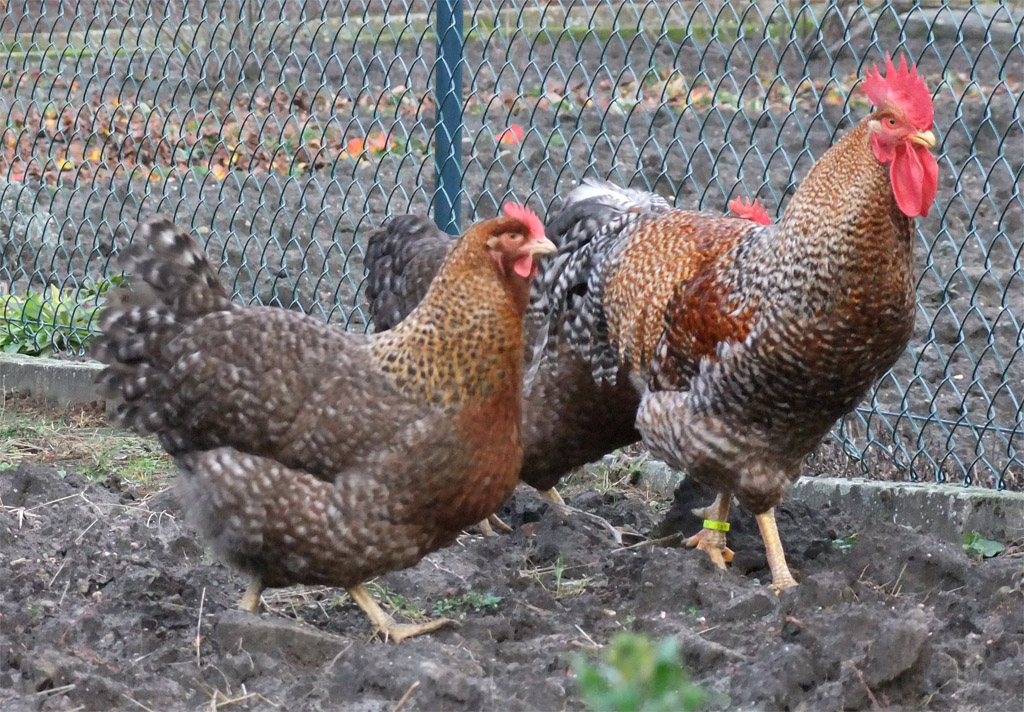
Bielefelder chickens are dual-purpose birds, meaning they lay large brown eggs and cook up nicely for meat. They strike a great balance between the two and have been bred this way specifically.
These birds tend to start laying beginning at 22 weeks of age and can produce between 230-280 extra-large eggs each year (roughly around 4-5 a week). Eggs produced by Bielefelder hens may range from brown to dark brown. Some owners claim they lay the biggest eggs they’ve ever seen.
This poultry breed is known for its efficient egg production and desirable meat quality, which competes nicely with the best breeds.
Bielefelder chickens are the perfect blend of impressive looks and cheerful personalities. These birds love to spend time outdoors or in the coop with their owners. It’s not uncommon for them to come running when they see a human, even without being tempted with treats. What’s more, Bielefelder roosters make great ‘team players.’ They are gentle giants and get along well in mixed flocks, making them one of the top friendliest chicken breeds on this list.
Brahma
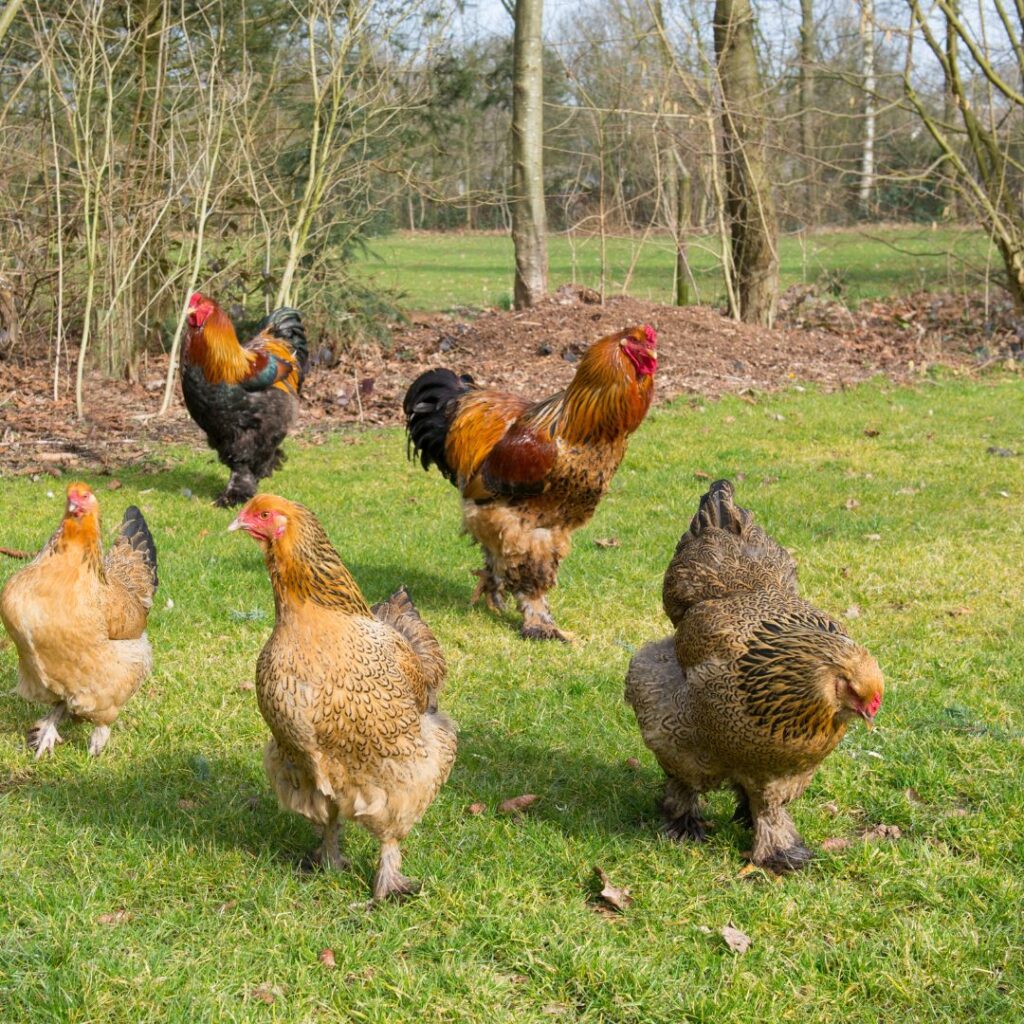
The Brahma chicken is truly a dual-purpose bird. From the 1840s until the 1930s, these chickens became the primary source of meat for the United States. With an average weight of between 9 and 12 pounds when fully grown, you can imagine how much meat one bird alone can generate. But that’s not all that makes the Brahma one of the best chicken breeds for pets.
Their size, fluffy feathers, and feathered legs help keep them warm in cold climates.
Brahmas are known for being productive layers of eggs, complete with the traditional color of brown. On average, hens start laying after 6-7 months but sometimes up to 12 months, producing around 200 eggs each year. Each hen lays from 4 to 5 large eggs per week.
With their calm and gentle nature, Brahma chickens make wonderful pets. Not only do they generally not mind being handled – even by little hands – but they are also known for being incredibly safe and one of the friendliest chicken breeds around kids. Even the roosters are gentle and pet friendly.
People love having these sweet birds as a part of their family and often become very attached to them. So if you’re looking for pet chickens that will be gentle and show some personality, you can’t go wrong with the friendly Brahma breed.
Cochin

Cochin roosters weigh 11 pounds, while hens weigh a bit less at 8.5.
Cochins are gentle giants that thrive in small backyard flocks. This is one of the calmest and friendliest birds you’ll set eyes and hearts on. They get along well with other breeds and love spending time in their backyard, rarely going far from their coop or run. At first, Cochin chickens can be shy around humans, but they warm up to people quickly and become friendly with patience.
Thankfully, Cochin roosters are less aggressive than other breeds and have even been known to sit on eggs and ‘babysit’ for broody hens.
That is a score for one of the friendliest breeds of chicken dads! These chickens are quiet, and their roosters won’t make much noise compared to other breeds.
Cornish Chickens
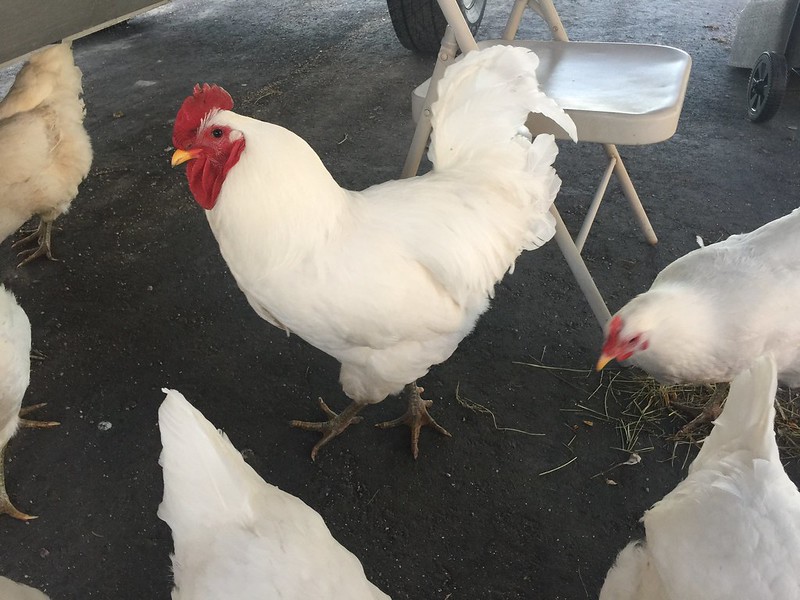
The Cornish chicken is a heritage breed from Cornwall, England, in the 19th century. It was created by crossing two existing breeds of chickens: the Dorking and the Plymouth Rock.
Cornish chickens are easily distinguishable among other flock mates because they are large, weighing 9- 12 pounds. Both hens and roosters have similar body shapes, which isn’t the case with other chicken breeds.
They have features that make Cornish chickens ideal for people living through harsher and colder winters.
Cornish chickens are the way to go if you’re looking for eggs and meat. In 18-22 weeks, they will be ready to get down to business – producing 150 eggs a year.
They have large breasts, making them some of the most succulent meat birds. Their tender and delicious meat will also leave your taste buds singing praises.
Cornish chickens are known for their quiet, docile personalities. They’re great if you want to keep poultry in your backyard or urban homestead and make for a fun family activity. It’s important to remember that despite their gentle nature, all animals need supervision when children are nearby.
Roosters, in particular, are more territorial and may puff up or flap around if someone encroaches on their space. Still, any threats of aggression towards people by Cornish chickens are usually isolated.
Easter Eggers
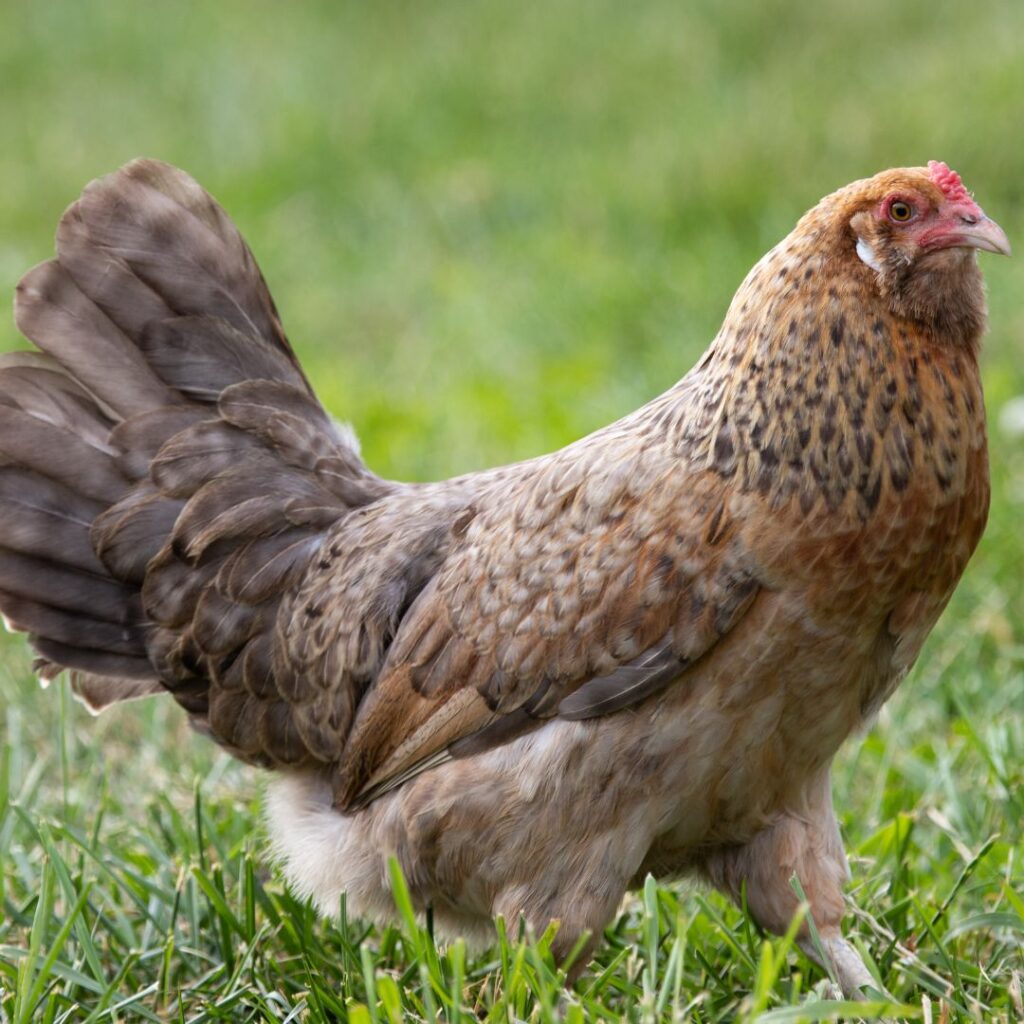
The Easter Egger hybrid is most recognizable by its eggs. Instead of boring ol’ brown or white eggs that most chickens lay, the Easter Egger offers various colors, including green, olive, aqua, pink, and even cream-colored and chocolatey-colored eggs. – giving owners a chance to collect a rainbow of eggs in their cartons every morning.
Easter Egger chickens’ friendly and curious personalities make them a great addition to any family flock. They love interacting with people, especially children. Their gentle demeanor makes them unlikely to pick fights with other birds.
These birds are surprisingly quiet compared to other breeds, so they are much less likely to disturb you or your neighbors.
When choosing a breed of chicken, it’s important to note that the Easter Egger may not do well with more aggressive breeds. They do well with docile breeds, such as Cochins or Orpingtons, when looking at other friendliest chicken breeds for your flock.
Golden Comet (aka Cinnamon Queens)
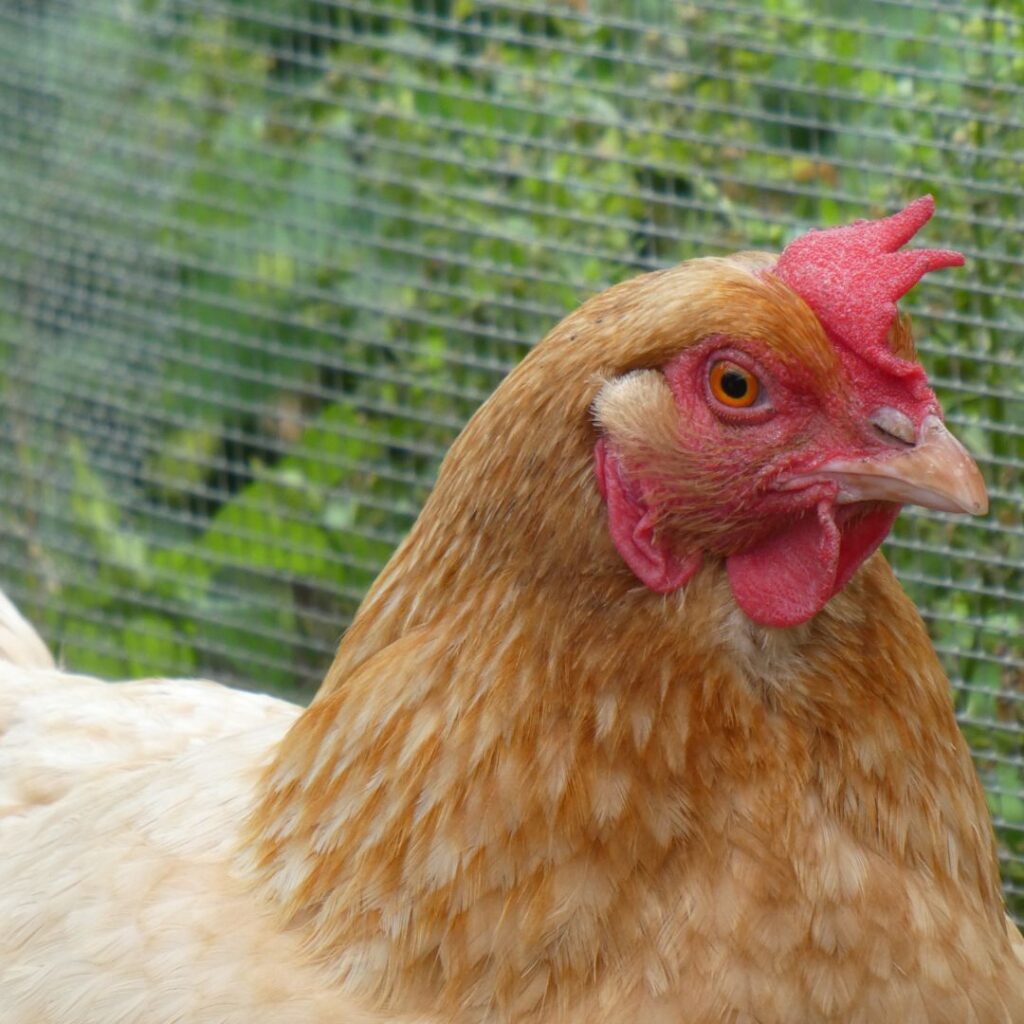
The Golden Comet chicken is a highly sought-after bird due to their fast maturity, hardiness, and dependence! They reach laying age at 16 weeks, much earlier than many other hens, and lay between 280-320 eggs per year.
As a cross between the R.I. Red and White Rock breeds, they have inherited the best qualities of both breeds, making them an all-around choice for one of the friendliest chicken breeds.
In the flock, these chickens are known for keeping the peace and moving away if they sense conflict.
The Golden Comet chicken is a personable bird, becoming quickly attached and socializing with their owners. They’re pretty calm and mellow, not minding being picked up by people. Sitting in laps and joining in snacks are frequent events when owning a Golden Comet. It’s not unusual for them to become beloved family pets.
Jersey Giant

If you’re looking for a large, muscular chicken breed to provide eggs and meat, the Jersey Black Giant may be an excellent choice. The Black Jersey Giant has a reputation as the largest chicken breed.
They don’t provide quite as many eggs as other chickens, about four eggs per week or 175-250 per year, but their substantial size makes them excellent table birds, and roosters can weigh up to 13 pounds. The dependable stature of these chickens provides extra assurance of satisfying your culinary standards.
The Jersey Black Giant is known for being a docile breed, making it one of the most attractive and friendliest chicken breeds to adopt as good pets. They are friendly and social, usually getting along well with both children and other chickens.
With an alert but even-tempered nature, this chicken breed will fit in almost any flock or family. As docile breeds, they are less likely to become aggressive than some other chickens while still providing their owner with the companionship they need and plenty of eggs to enjoy.
Marans
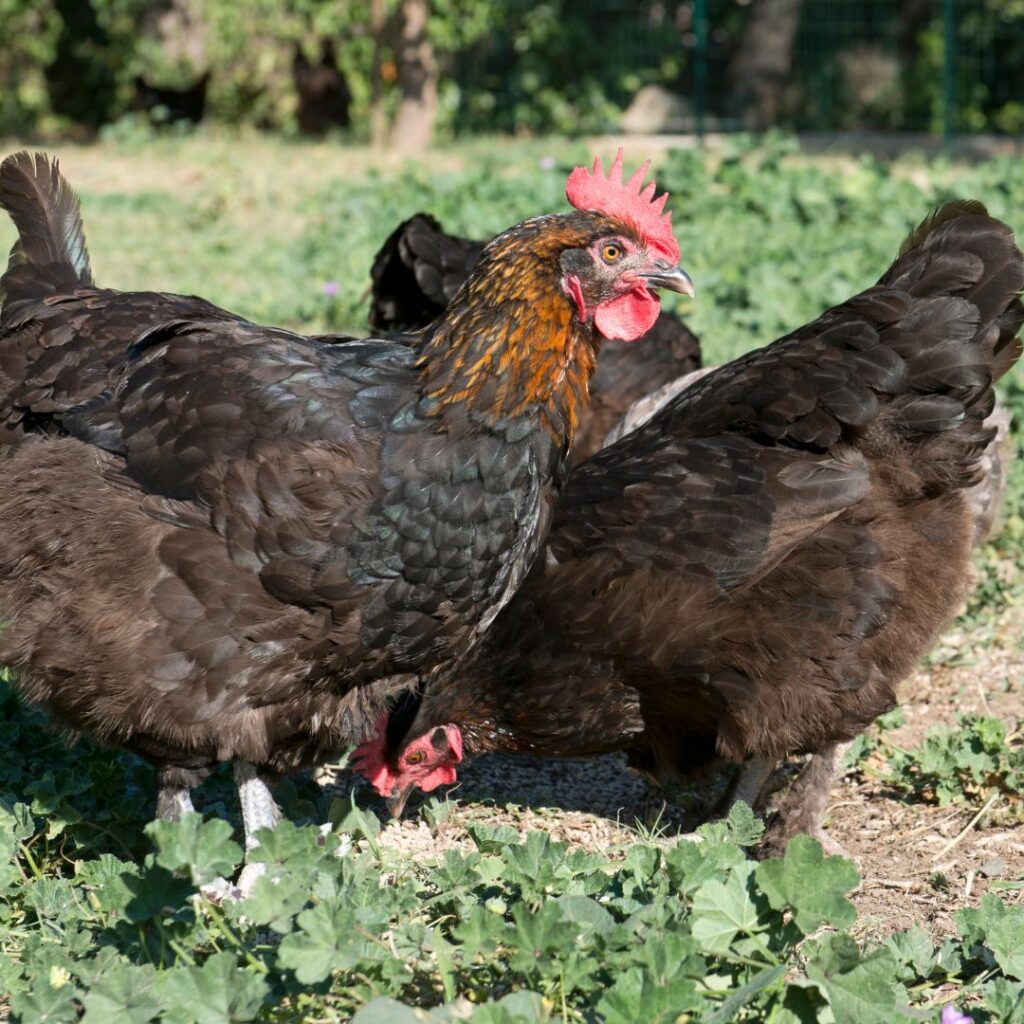
Marans Chicken is great for both meat and eggs! While all the color varieties of this French Black Copper breed can lay up to 200 of the darkest eggs, you’ll ever see. Some U.S. hatcheries offer hybrid Marans breeds with even more – up to 250+ dark brown eggs a year.
The large rooster of the Marans chicken makes for tasty meat, and although they have slower maturity rates than breeds like the Cornish Cross, their best use of mean is in the slow cooker, stew, or soup meals.
The Marans do well in cold climates with proper chicken coop preparation.
Marans chickens are known to be gentle and calm companions, making them ideal backyard flocks. The hens are incredibly docile and get along well with their coop mates, rarely engaging in bullying.
Even the roosters exhibit a gentle demeanor and are less aggressive than other roosters, but they won’t hesitate to stand up to bullies.
Males and females are quieter than many chicken breeds, making them a good choice for pets in urban/ city chicken homes.
Mille Fleur D’Uccles

They start laying eggs at between 5 to 6 months of age, and each week they produce around 2 to 3 small “bantam-sized eggs” – the color is usually cream-colored. Over a year, they can lay up to 120-150.
Mille Fleur d’Uccles are charming little birds known for their friendly and chatty demeanor. They have an intense curiosity and often fly up to perch on shoulders or even heads to get a better look around. The females are usually timider, while males typically demonstrate an outgoing personality.
With time, these friendly bantams may even follow you around your yard or hop onto your shoulder whenever you go outdoors. All of this makes Mille Fleur d’Uccles one of the most popular backyard pets.
Orpington

The Buff Orpington is a dual-purpose bird, boasting bountiful light brown to brown eggs and delicious meat. With the proper care, these large birds will start laying medium to large eggs around the 5-6 month mark, producing roughly 200 -280 per year.
While they may slow down during the winter months, where days are shorter, you can count on your chickens providing about 4-6 eggs each week year-round.
When it comes to meat production, this breed does not disappoint either. You’ll be rewarded with a delicious table bird by bringing a rooster to market at 22 weeks.
The Buff Orpington chicken is often called the ‘golden retriever’ in the chicken world. That’s because these friendly chickens are gentle and docile and enjoy being around humans and animals – making them beloved pets for backyard chicken owners. This is one of the best choices for chicken breeds for pets.
Despite a typical rooster’s more aggressive demeanor, Buff Orpington roosters are relatively mild-mannered and well-behaved.
They may be slightly more observant than their hens, but when cared for correctly, they make excellent family pets with their playful personalities.
Plymouth Barred Rock
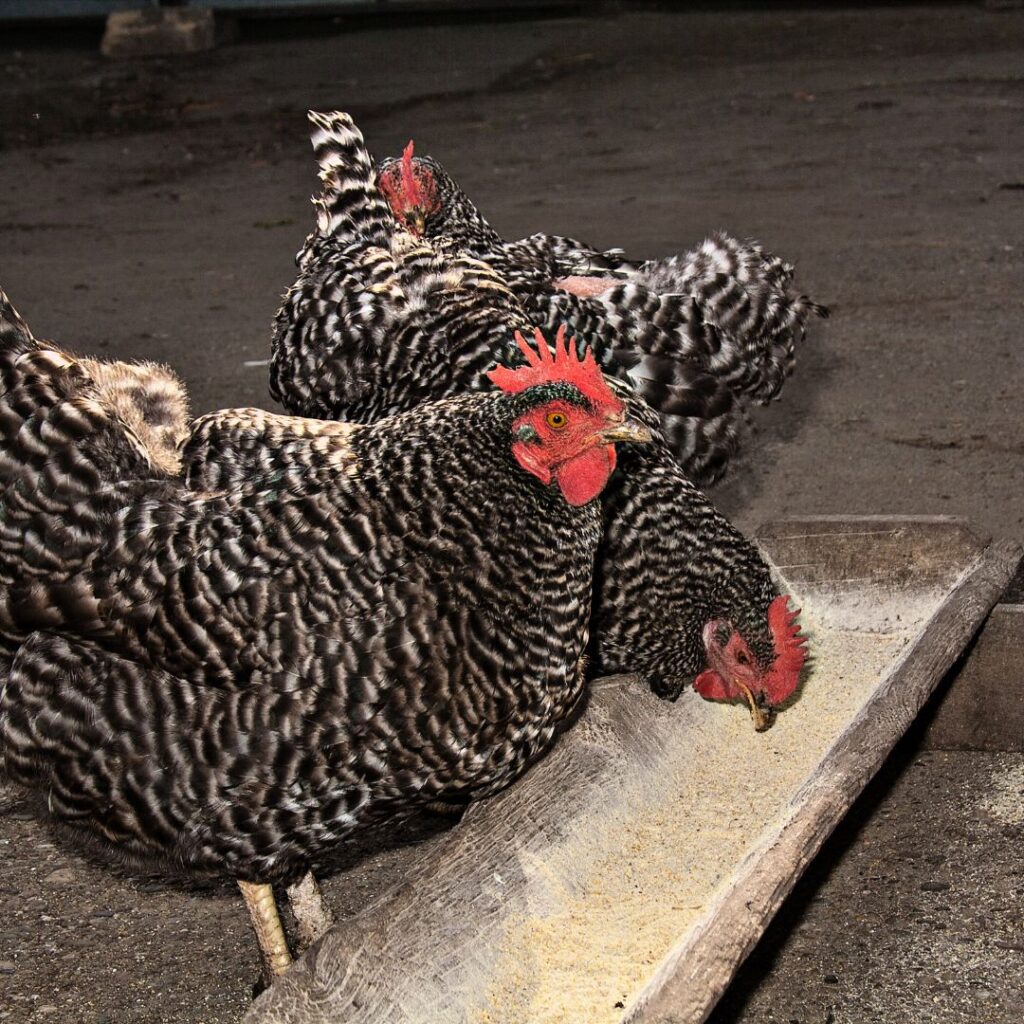
The Plymouth Barred Rock is a multi-purpose bird known for its meat and eggs. They are dual-purpose chickens, meaning they can be used for both purposes. The roosters weigh 9.5 pounds on average, making them a good choice for those looking to raise their table birds.
The hens begin laying eggs at around 20 weeks old and are excellent layers of up to 280-300 eggs yearly, 5- 6 eggs a week. The eggs are large and brown. Barred Rocks tend to be reliable layers, producing a steady supply of eggs and rarely taking breaks in production.
The Plymouth Barred Rock is an ideal bird for keeping as a pet. Its friendly, curious nature makes it an excellent choice for family-friendly backyards, and its quiet disposition ensures that it can be kept in more urban and suburban areas.
The Barred Rock is tolerant of being handled and receiving affection from younger egg collectors. In addition to its personable character, this chicken is also known for being an active and playful breed. An excellent breed for a family pet!
Polish
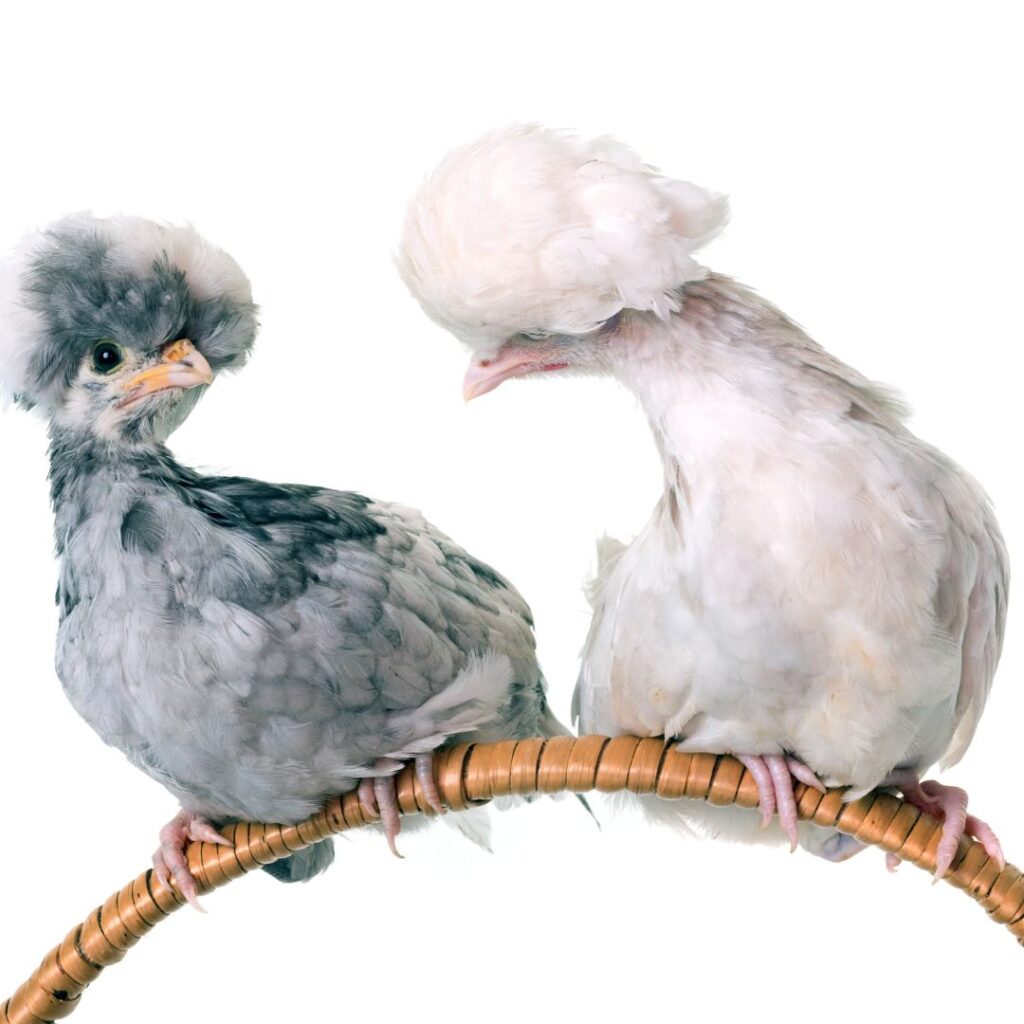
Polish chickens have feathered crests that nearly cover their entire head and can come in standard and bantam sizes. The crest is the most appealing feature of the Polish chicken breed, often called a tophat or pompom. Polish is genuinely unique in appearance, behavior, and intelligence.
When considering raising Polish hens for eggs, you can expect a consistent supply of white eggs around 20 weeks after the baby chicks have hatched. This hen typically lays 2-4 eggs weekly, making up to 200 small white eggs in one year.
You may be disappointed if you’re looking for meat from them; Polish poultry haven’t been explicitly bred to produce as meat birds.
Polish chickens make lovely pets, especially for children, as they are gentle and friendly. However, they can be easily frightened, skittish, and flighty due to poor vision since they have a large tophat of feathers around their head.
To help them feel safe and comforted, it is best to handle these birds with gentleness and stay consistent with love and kindness. Polish chickens are ideal for enthusiasts who don’t mind providing their feathered companions extra reassurance.
Polish Chickens: Pom Pom, Top Hat Chickens; All About
Red Or Black Star Sexlinks
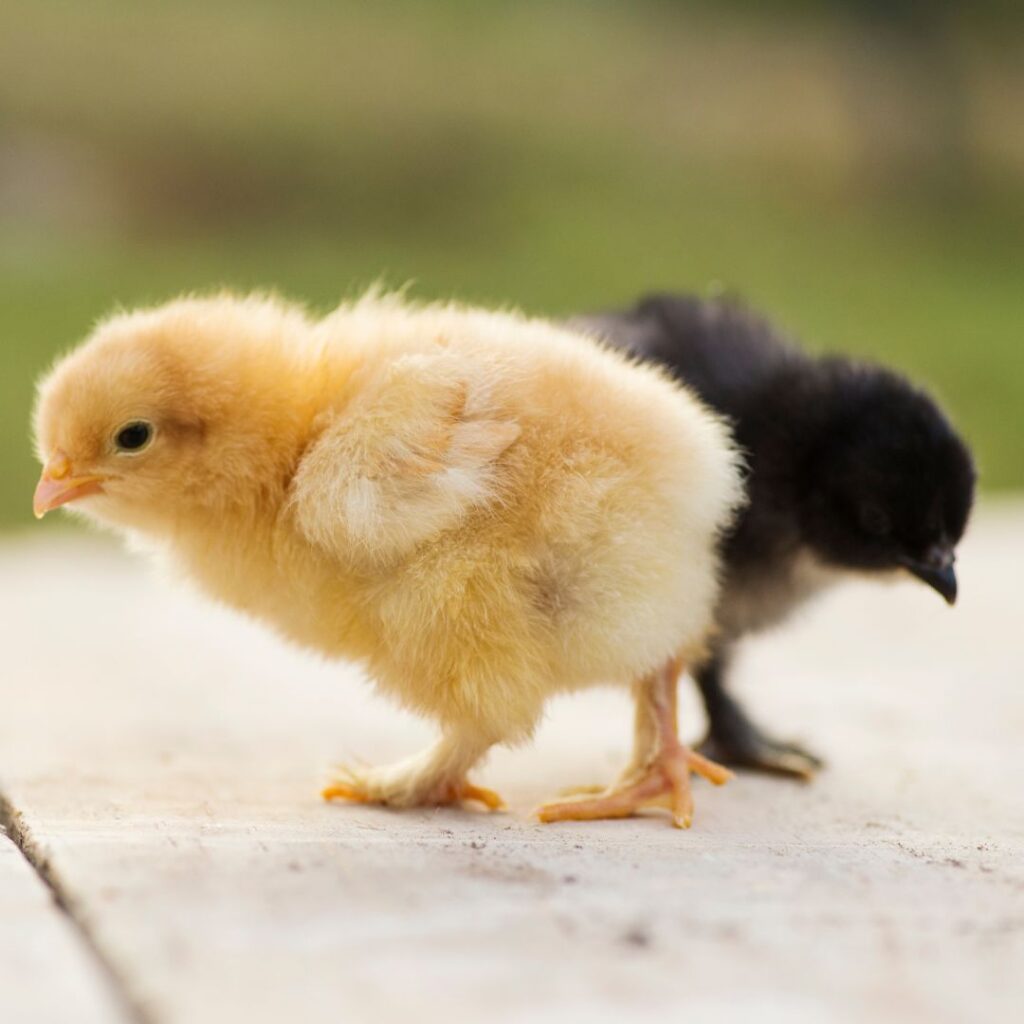
Black Star sex link chickens are a hybrid poultry breed developed in the post-WWII era to meet America’s growing demand for eggs and poultry.
They were created by cross-breeding hardy and high-quality breeds with prolific egg layers. Black Star hens are known for starting their egg laying early in life and continue this throughout, making them an ideal choice for farmers looking for reliable sources of eggs.
Moreover, they’re recognized as one of the cold-hardy chicken breeds that can thrive even in the harshest winter conditions – no matter what Mother Nature throws them.
The hens lay approximately 280 eggs per year/ 5-6 large – extra large brown eggs per week.
While they are great pet chickens for their eggs, they are docile and good-natured and don’t tend to interact with humans like other breeds.
Rhode Island Reds
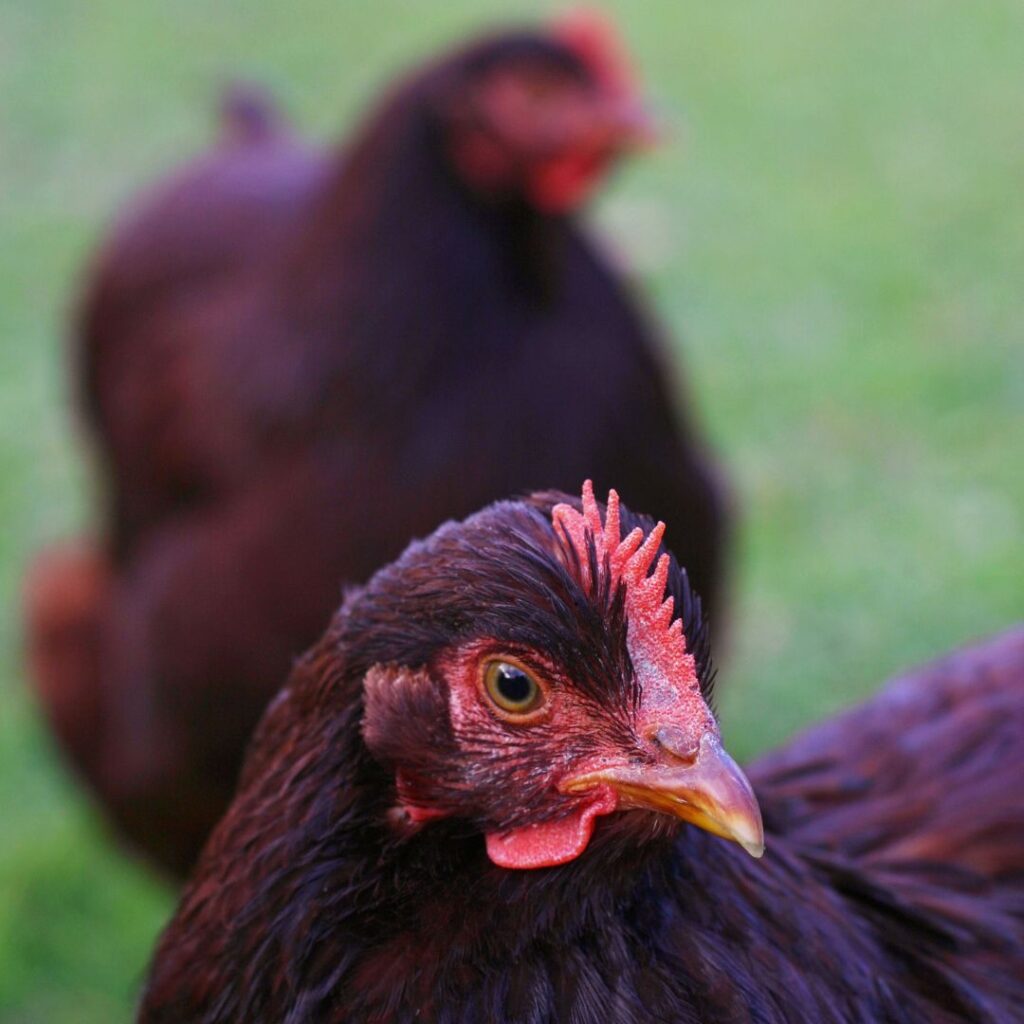
With their origin initially meant as a dual-purpose bird, the R.I. Red has grown to be known mainly for its egg-laying qualities. This breed excels in egg production by offering up to 280 large brown eggs over 12 months. And remember the meat! They are of suitable size for efficient meat production, making them an excellent choice for those looking for a source of both eggs and meat.
The Rhode Island Red is an active bird and will thrive in free-range conditions. They are also known for being a very cold hardy bird.
They are chatty and noisy, probably not the choice bird for an urban neighborhood.
While the hens are generally docile and enjoy human companionship, the roosters can be territorial and somewhat aggressive.
This should be considered when mixing breeds, as a R.I. Red is higher on the pecking order than more docile birds like Cochins or Orpingtons.
As with all feathered friends, it’s best to hand-feed them in their early months so they get used to people and become less fearful.
Although not as friendly as some, these birds will eventually tolerate human presence if socialized from an early age.
Silkie
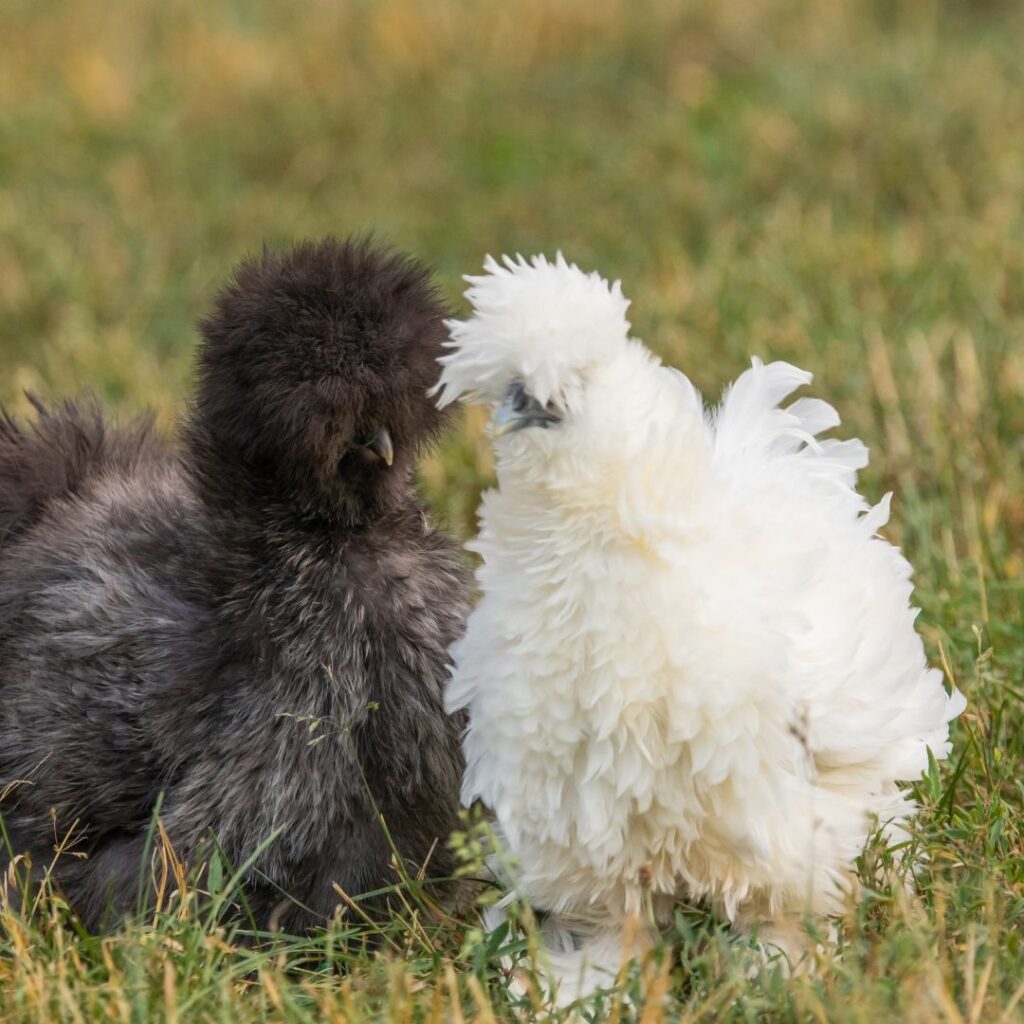
These Silky chickens are small compared to other chicken breeds. The roosters weigh around 4 pounds, and the females (hens) only 3 pounds.
Silkies are an incredibly unique breed of chicken. Their naturally black skin is one of their most striking features, along with bright blue earlobes. They are bred in standard and bantam sizes and can have a smooth or crested head. Another Silkie trait is their feet which are feathered and have five toes instead of the usual four.
Silkie chickens’ black skin and black meat make them even more unique in the world of poultry. They make a small meal of 1-1.5 pound prepared bird. If you’re brave enough to sample Silkie meat, you’ll find it tastes just like chicken but with a more robust flavor. Additionally, their broth is said to be used medicinally in China.
They lay 120 small eggs annually, nearly 2-4 eggs per week.
Silkie Chickens are one of the friendliest chicken breeds – truly soft-hearted! They have soft feathers and appealing personalities and are also great pets for families, especially those with children. They rarely stray far from their keeper, don’t fly away, or require a lot of space.
As one of the cutest chicken breeds, Silkie Chickens are excellent companions who are joyful, highly curious, and great conversationalists. Those wanting a gentle, entertaining pet should undoubtedly consider choosing them.
Speckled Sussex

The Speckled Sussex chicken is popular with its beautiful coloring and feather patterns. Adult roosters typically weigh around 9 pounds, while hens are generally 7 pounds.
They have a mahogany brown base with white-tipped feathers and a black strip separating the flight feathers. This unique coloration provides camouflage in the wild, and their speckling becomes more apparent with each molt.
If you’re looking for a backyard chicken that provides delicious eggs and a succulent flavor when it comes time to process them for meat, the Speckled Sussex is the bird for you.
The hens are great egg producers that start laying around 20 weeks of age, and they are great egg producers that can lay up to four or five large brown eggs each week, which adds up to 240 per year.
When it comes time to harvest some poultry, this breed has plenty of flavor and even better dark meat than some commercial breeds. Enjoy homegrown pasture-raised poultry with your flock of Speckled Sussexes.
The friendly and calm Speckled Sussex chicken is the perfect companion for anyone interested in raising chickens. They are highly alert and curious, and their friendly nature allows them to bond with their human owners, giving them a place on the list of the friendliest chicken breeds.
Even around children, these birds will approach eagerly, showing a remarkable enthusiasm for friendly attention. They have plenty of energy yet remain pretty quiet throughout the day, offering just enough chatter and conversation to satisfy even the most social homesteaders.
These friendly chickens make excellent pets for children looking to learn more about raising chickens in a positive and encouraging environment.
Turken
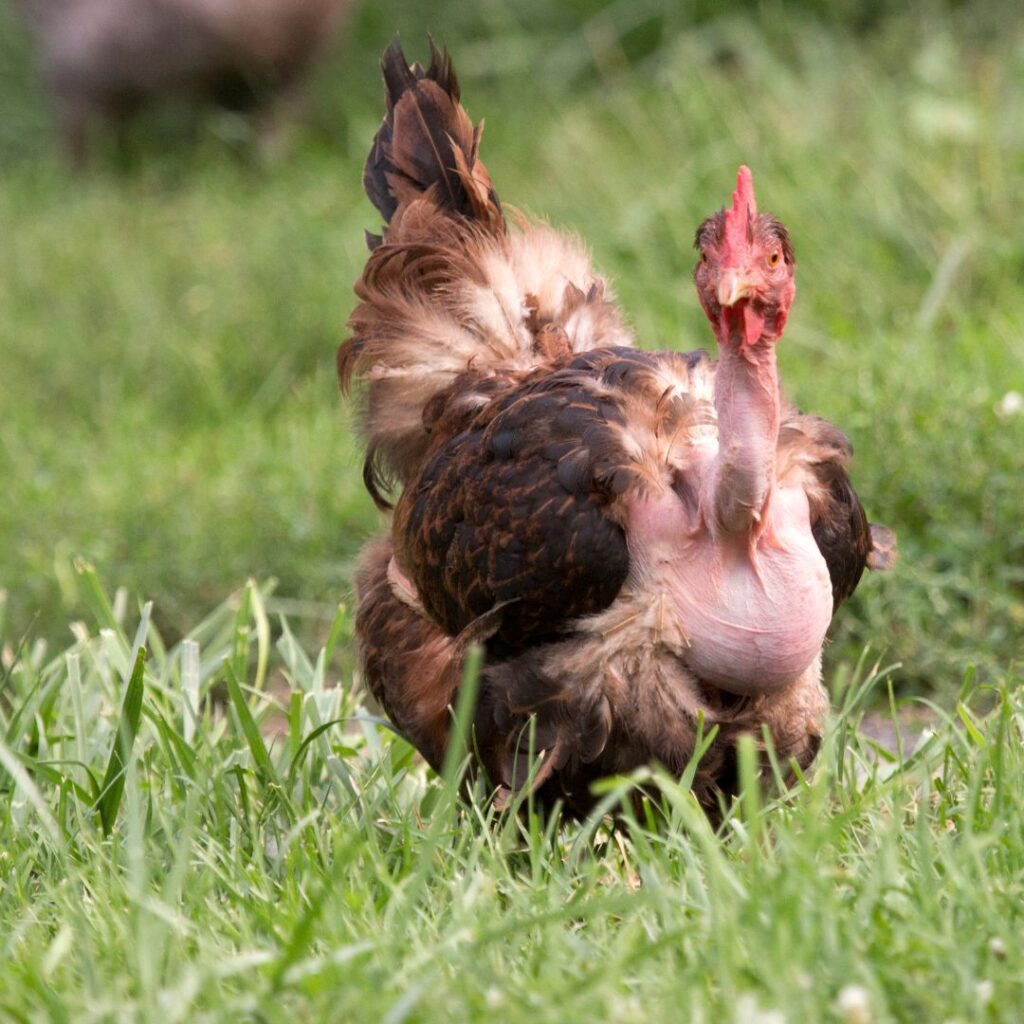
Naked Necks is an extra-large poultry breed. Roosters can grow to 8.5 pounds, and hens to 6.5 pounds when fully mature.
What truly stands out about them is their noticeable lack of feathers on their necks and heads, along with 40-50% fewer feathers overall than regular chicken, helping them stay cool on hot days. Read more about heat-tolerant chicken breeds here.
The Naked Neck hens are a great choice for those wanting to keep chickens for eggs and meat. They can reach maturity around 20 weeks and, on average 4 light brown eggs per week and about 200 large light brown eggs annually, although some hatcheries claim up to 240 yearly.
These friendly chicken breeds also tolerate all kinds of weather – from hot and humid to cold and windy days.
If you’re interested in them for their meaty qualities, know that they’re large at 8 pounds each, making them a good meal for families. They are also effortless to pluck, thanks to the featherless nature of their skin.
They are said to cook in a way the fat bubbles underneath, giving the meat more flavor than other broilers. Even though they go by the name “naked neck,” don’t expect them to taste like turkey meat.
The Naked Neck chicken is a wonderfully friendly chicken breed personality-wise. They are active and energetic, and each has its unique personality traits. They are known to be quite docile and also tend to be full of silliness, which makes them very enjoyable pets.
Naked Necks can create quite a conversation. They tend to be vocal creatures who demonstrate their personality. Their endearing chatter makes them an excellent choice for households with children, seniors, or anyone looking for that unique pet chicken in their flock.
Welsummer
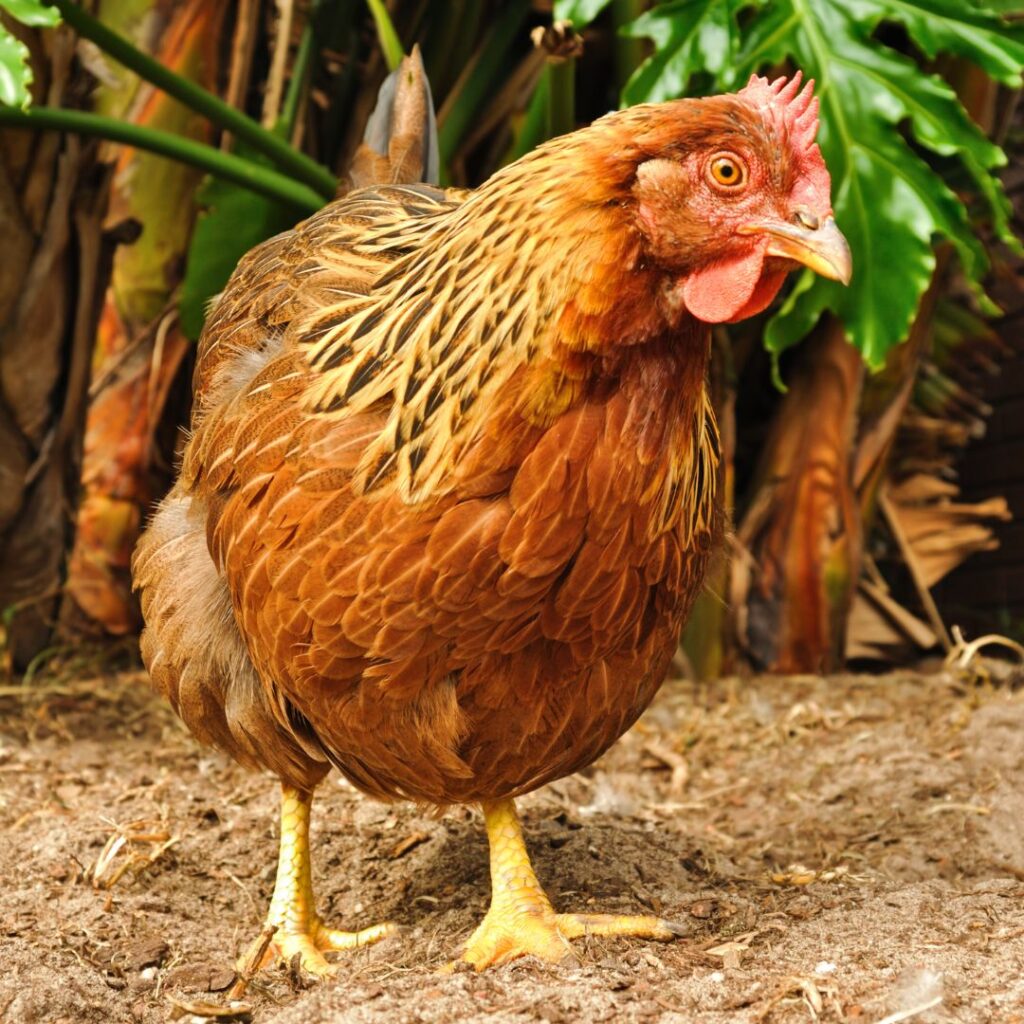
The Welsummer chicken is a truly beautiful sight! These medium-bodied birds are about 7 pounds for roosters and 6 pounds for hens. So, while they may not be considered ‘large,’ their full feathering creates a much grander visual appearance.
Reaching full maturity at 20 weeks, these birds begin their egg production around the same time. They are good egg layers, laying large, dark, and occasionally speckled eggs that can amount to 200-280 per year, 5-6 dark brown eggs per week.
Although smaller than traditional meat bird breeds, Welsummers have rich and flavorful meat that balances white and dark cuts.
Welsummers are some of the friendliest and most affectionate chickens to keep. With their docile behaviors, they make perfect additions to a mixed flock. They’re intelligent and active, easily adapting to their surroundings while keeping themselves amused for hours when out in free-range settings.
When protecting their flock, Welsummer roosters usually remain peaceful but will become assertive if necessary.
They’re often known for their frequent louder chatter, so they may not be the best choice for those with close-living neighbors.
With their cheerful personalities and lively attitude, a well-raised Welsummer can be an excellent pet chicken and is sure to bring plenty of vocal entertainment to any backyard.
White Leghorn

Today, they are one of the most popular laying chicken breeds used in commercial egg-farm for their prolific egg production but also make great backyard chickens. Whether you’re looking for a pet chicken who will shower you with personality or high amounts of egg-laying capabilities, look no further than a trusty Leghorn.
Leghorns will reach maturity and start egg-laying around 18-20 weeks. However, quite a few have been known to start as early as 16 weeks. With great egg production that can reach up to five eggs a week, 280-320 eggs in a year, and large- to extra-large white shells, these chickens make for great egg layers.
The meat, however, is not their strong point; leghorns have small bodies, which means tough meat, so if you need to reduce numbers in your flock, they are better left as ‘soup birds.’
Leghorn chickens are popular amongst backyard chicken owners not just for their impressive egg-laying but also for their unique personalities. They can be described as active and intelligent, allowing them to happily forage for food on their own if given a chance.
To ensure your Leghorn flock is happy and healthy, ensure they have plenty of space to move around, so they don’t become bored or aggressive.
While they are not “lap” chickens, they are known to be confident enough to follow their pet owners around and help with garden chores if given the opportunity!
What Chicken Breeds Have The Friendliest Roosters?
You’ll want a rooster if you want fertilized eggs for future chicks. Roosters should never be matched with smaller hens; they can cause damage.
You want to proportion the number of hens you have with the number of roosters. Most breeds are at most one rooster for every ten hens. Check your hatchery or our breed links for the details.
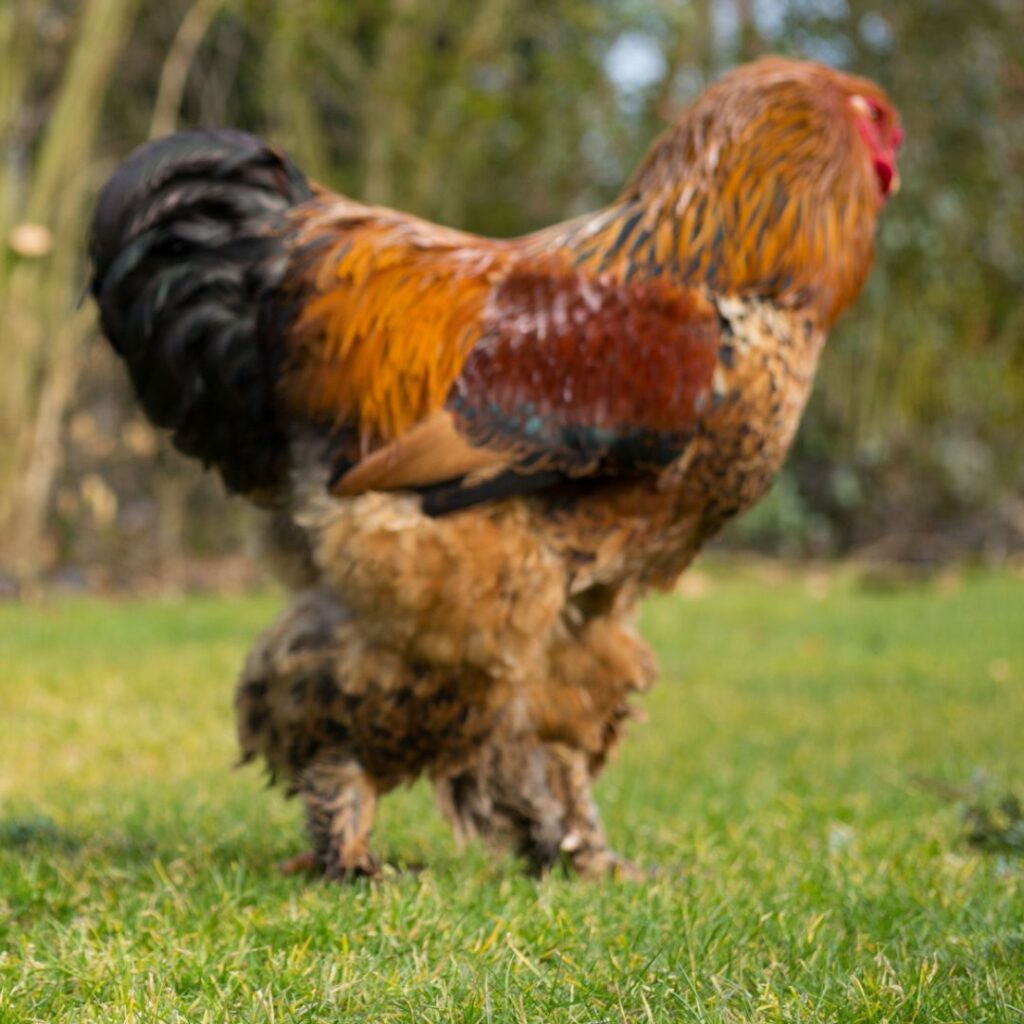
These are the 6 Friendliest Roosters:
- Brahmas
- Cochins
- Favorites
- Silkies
- Orpingtons
- Wyandottes
What chicken breeds are most affectionate?
- Australorps
- Cochins
- Orpingtons
- Silkies
- Speckled Sussex
What Are The Friendliest Breeds That Like To Be Held?

- Silkies
- Brahma
- Cochin
- Orpingtons
What Friendly Chicken Breeds Make Good Moms?
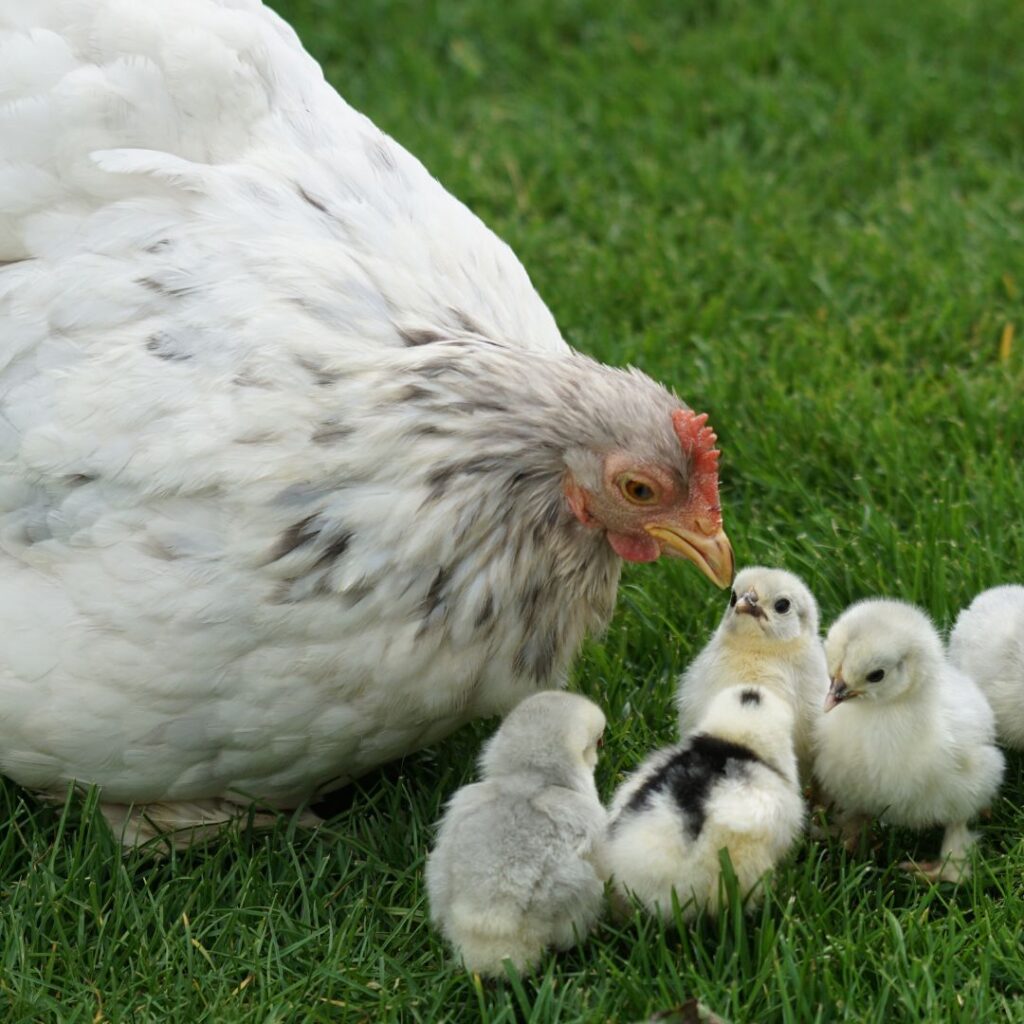
- Belgian D’Uccle
- Brahma
- Cochin
- Favorite
- Mille Fleur
- Orpington
- Silkie
- Turkens
- More broody chickens here along with broody tips
Can A Backyard Flock Roam free in the yard?

Yes, roaming and foraging is a chicken’s favorite activity. Some chickens are better than other breeds at being predator savvy, so it’s always a good idea to provide supervision, even a webcam, to alert you to problems.
What Are 10 Pet Chicken Breeds Best For Urban Neighborhoods?
- Ameraucana
- Australorp Chickens
- Barred Plymouth Rock
- Brahma
- Cochin
- Easter Eggers
- Marans
- Orpington
- Sussex
Wyandotte
What Friendly Breed of Chickens Are Cold Hardy?
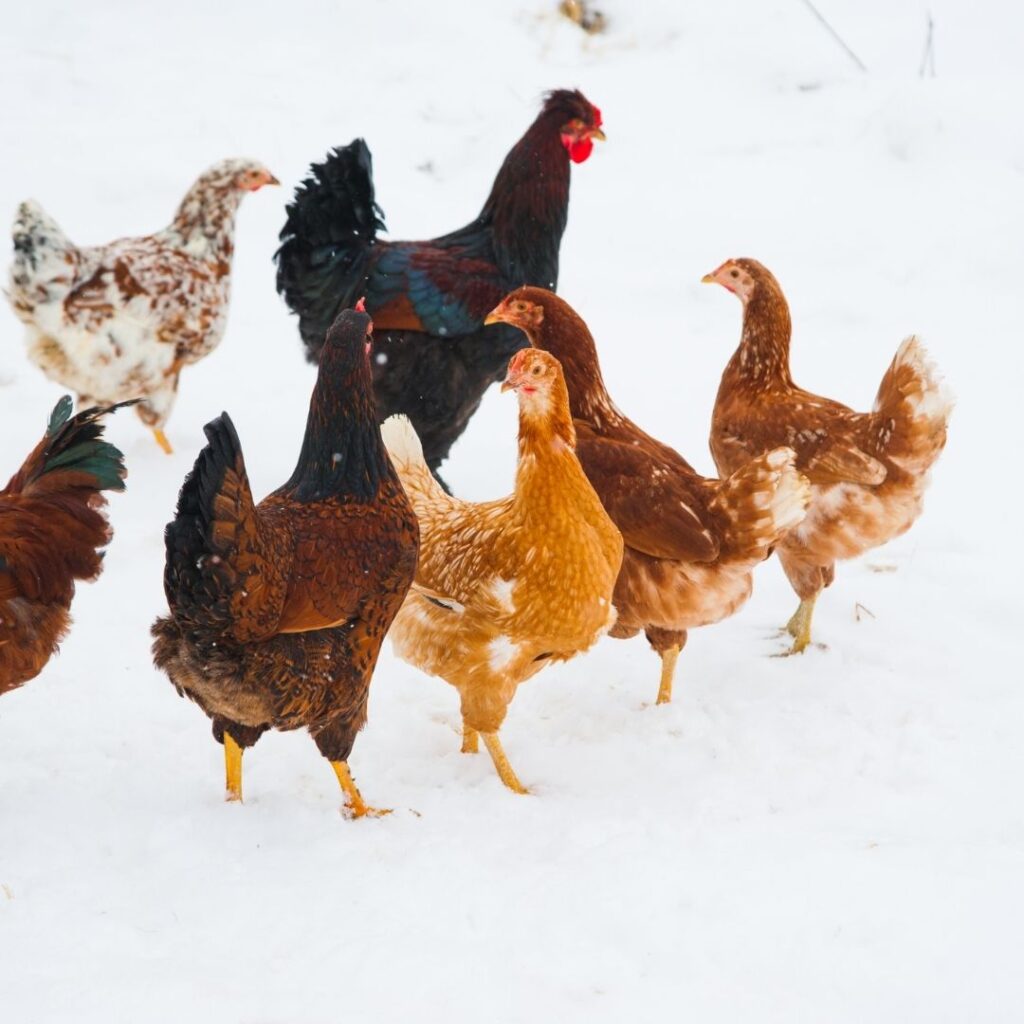
- Ameraucana
- Australorp
- Brahma
- Buckeye
- Chantecler
- Cochin (Buff Cochin)
- Delaware
- Dominique
- Easter Eggers
- Jersey Giant
- New Hampshire Red
- Olive Egger
- Orpington (Buff)
- Rhode Island Red
- Speckled Sussex
- Silkie
- Welsummer
- White Leghorn
- Find out how to help your hen lay eggs into the winter months
Is it worth it to raise your Pet Chicken?

On the practical side, raising chickens as pets can result in an abundance of organic eggs with the bonus of recycling food scraps. They’ll provide plenty of organic fertilizer if you have a garden in your yard.
Did you know because of the quality of life and feed a chicken receives, their eggs are more nutritious in value than a store-bought eggs?
If you keep your flock reasonably sized to feed your own family, the cost to raise chickens as pets and for eggs will pay off in eggs alone. Free-ranging allows your chickens to forage for healthy food and can also cut feed costs.
You can look into selling your fresh farm eggs at your farm stand, but even better, donate eggs to a food bank or local shelter!
What Are the Benefits of Keeping Chickens As Pets?

There are so many reasons why people choose to keep chickens as pets! One of the biggest perks is that chickens can provide fresh eggs from your backyard.
You may also be surprised to learn that hens do not need a rooster to produce or lay eggs; they only need food and water!
Keeping chickens for pets also provides entertainment; watching their antics can be amusing!
Finally, raising chickens teaches children valuable lessons about life cycles, animal care, and responsibility.
A backyard flock is worth considering whether you’re looking for fresh eggs or fun backyard entertainment. Remember, they reduce insect populations in your yard and provide organic fertilizer for your garden.
You can turn your backyard into a thriving home for your flock of feathered friends with proper care and dedication.
Did you know Chickens are also being used as emotional support and therapy animals?
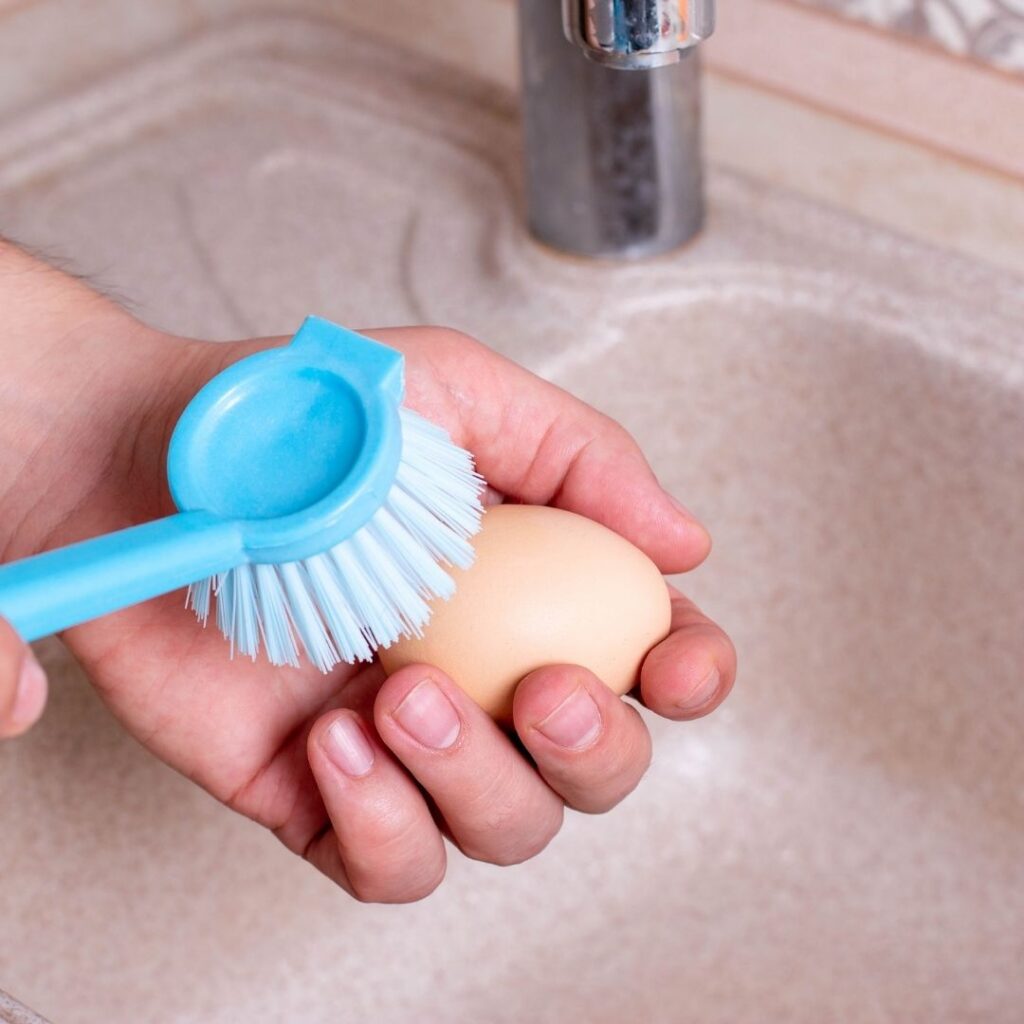

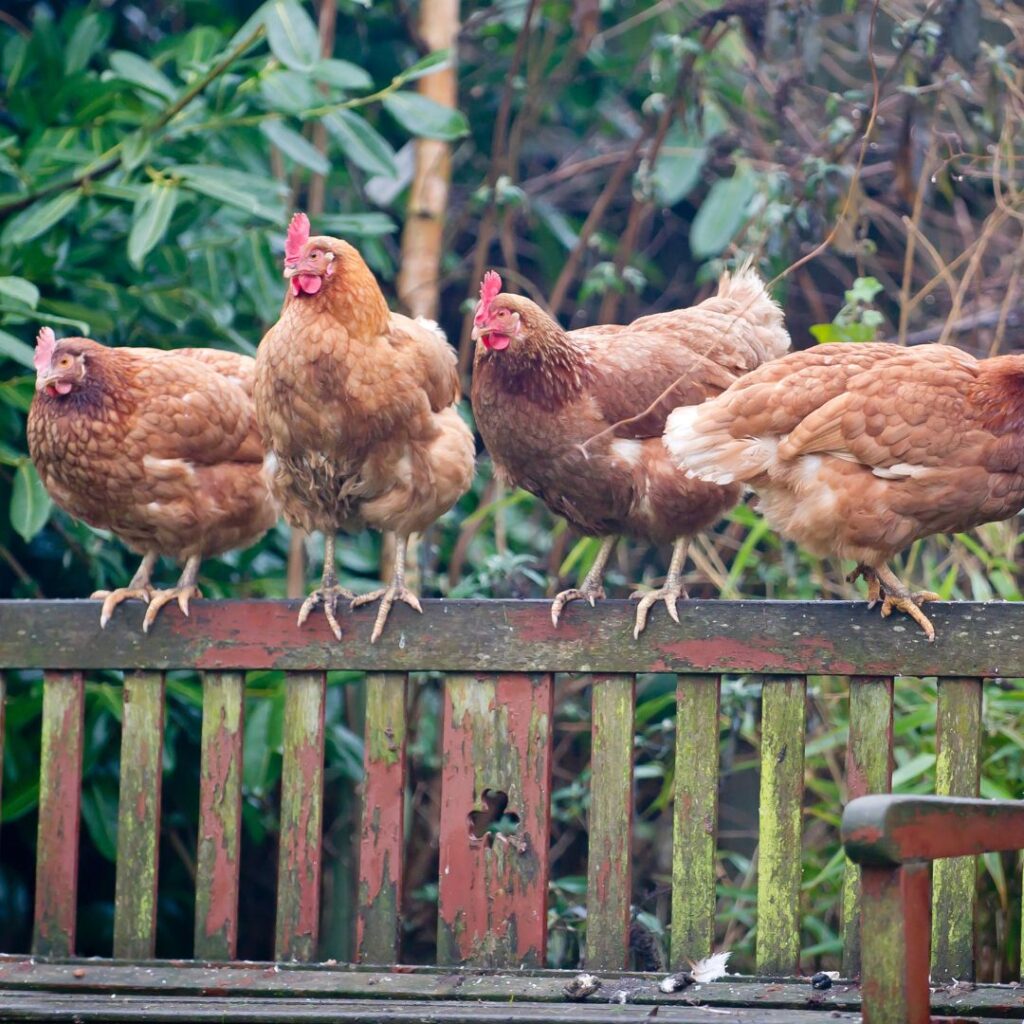

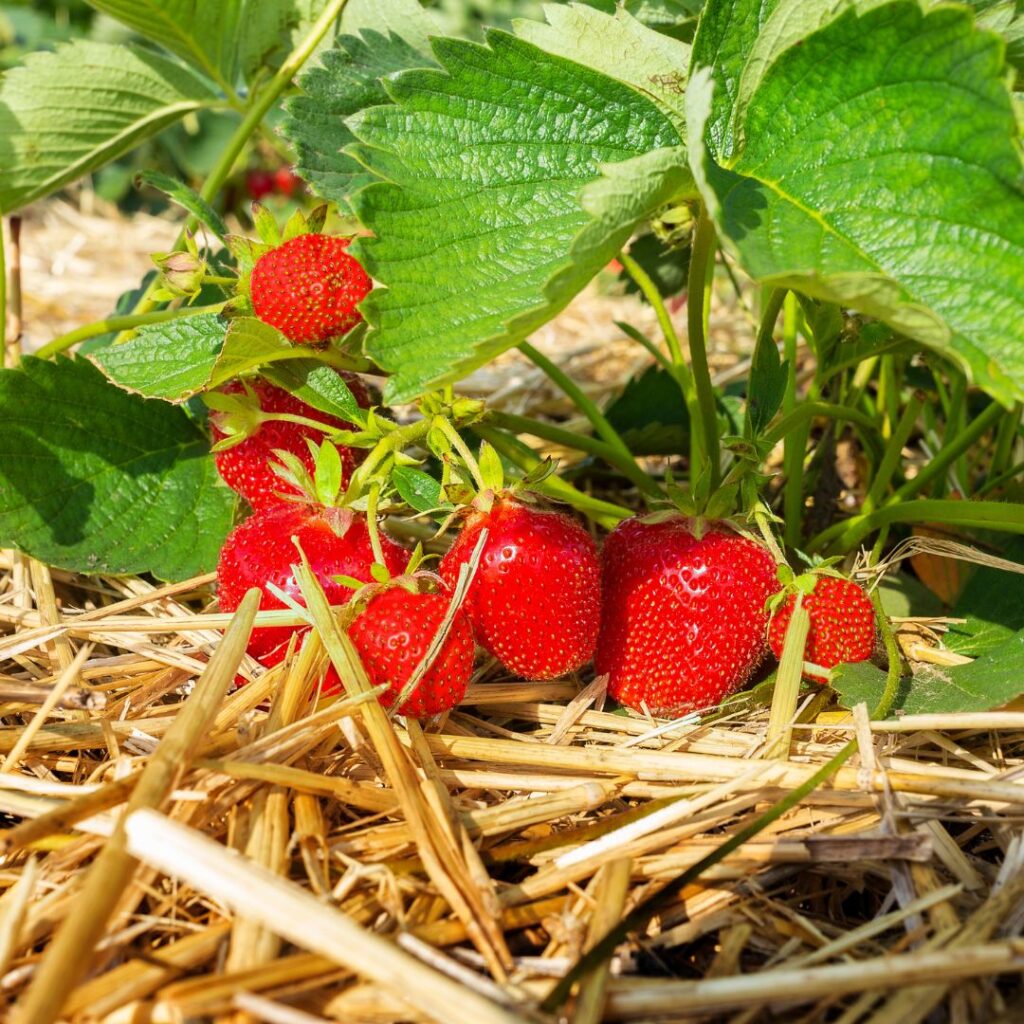
Pingback: Dominique Chickens; The Pilgrim Fowl - All About This Breed
Pingback: Bielefelder Chickens: About This Beautiful Chicken Breed
Pingback: Speckled Sussex Chickens; Is This Breed Right For You?
Pingback: Cochin Chickens: What To Know - Gilmore's
Pingback: Jersey Black Giant Chickens: The Breed For You? - Gilmore's
Pingback: 15+ Best Egg Laying Chicken Breeds; Qty, Color, Size Of Eggs
Pingback: Brahma Roosters and Hens: All About
Pingback: Cream Legbar Chickens: About The Breed And Its Needs
Pingback: Golden Comet Chickens; About This Sex Link Hybrid Chicken
Pingback: 11+ Quiet Chicken Breeds That Make Great Neighbors In Urban Areas
Pingback: Welsummer Chicken; Beautiful Dark Brown Eggs And More-About The Breed
Pingback: Raising Backyard Chickens; Tips For Beginners - Gilmore's
Pingback: Cornish Chickens: A sweet Heritage Breed - Gilmore's